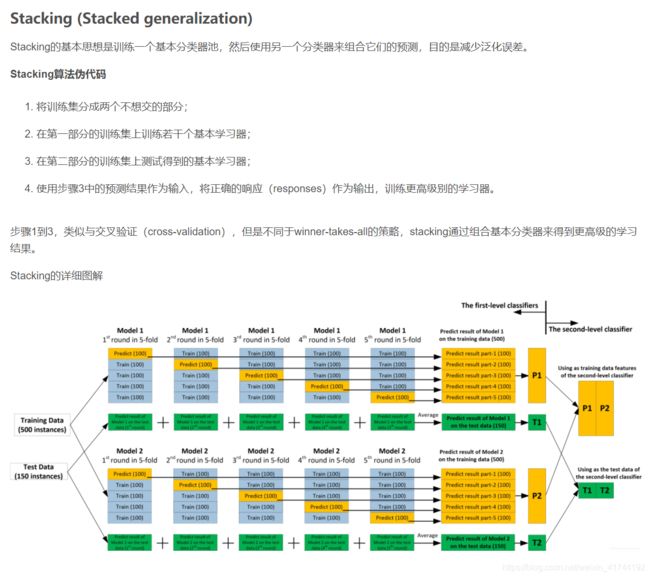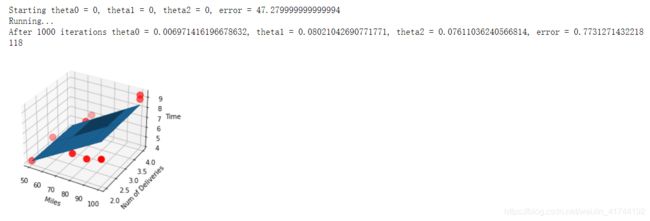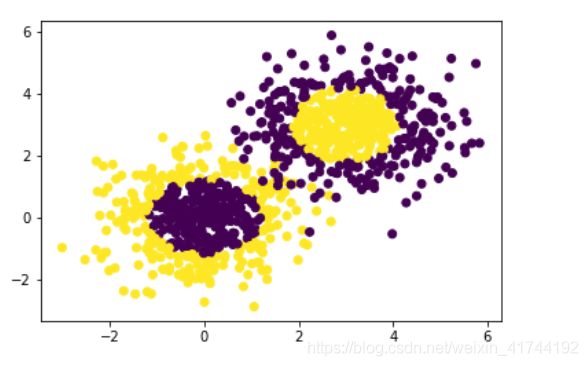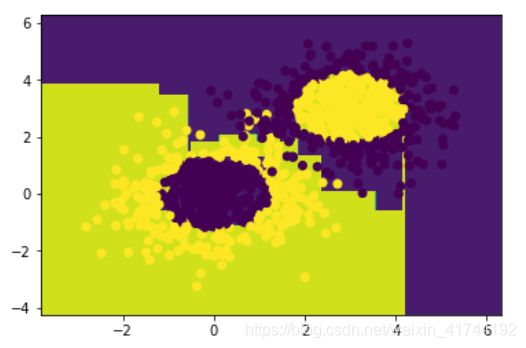机器学习十大算法案例
机器学习十大算法与案例实现
- 监督学习
-
- 1. 线性回归
- 2. 逻辑回归
- 3. 神经网络
- 4. SVM支持向量机
- 5. K邻近
- 6. 贝叶斯
- 7. 决策树
- 8. 集成学习(Adaboost)
- 非监督学习
-
- 9. 降维—主成分分析
- 10. 聚类分析
监督学习
1. 线性回归
梯度下降一元线性回归
import numpy as np
import matplotlib.pyplot as plt
# 载入数据
data = np.genfromtxt("data.csv", delimiter=",")
x_data = data[:,0]
y_data = data[:,1]
# 学习率learning rate
lr = 0.0001
# 截距
b = 0
# 斜率
k = 0
# 最大迭代次数
epochs = 50
# 最小二乘法
def compute_error(b, k, x_data, y_data):
totalError = 0
for i in range(0, len(x_data)):
totalError += (y_data[i] - (k * x_data[i] + b)) ** 2
return totalError / float(len(x_data)) / 2.0
def gradient_descent_runner(x_data, y_data, b, k, lr, epochs):
# 计算总数据量
m = float(len(x_data))
# 循环epochs次
for i in range(epochs):
b_grad = 0
k_grad = 0
# 计算梯度的总和再求平均
for j in range(0, len(x_data)):
b_grad += (1/m) * (((k * x_data[j]) + b) - y_data[j])
k_grad += (1/m) * x_data[j] * (((k * x_data[j]) + b) - y_data[j])
# 更新b和k
b = b - (lr * b_grad)
k = k - (lr * k_grad)
return b, k
print("Starting b = {0}, k = {1}, error = {2}".format(b, k, compute_error(b, k, x_data, y_data)))
print("Running...")
b, k = gradient_descent_runner(x_data, y_data, b, k, lr, epochs)
print("After {0} iterations b = {1}, k = {2}, error = {3}".format(epochs, b, k, compute_error(b, k, x_data, y_data)))
#画图
plt.plot(x_data, y_data, 'b.')
plt.plot(x_data, k*x_data + b, 'r')
plt.show()
import numpy as np
from numpy import genfromtxt
import matplotlib.pyplot as plt
from mpl_toolkits.mplot3d import Axes3D
# 读入数据
data = genfromtxt(r"Delivery.csv",delimiter=',')
# 切分数据
x_data = data[:,:-1]
y_data = data[:,-1]
# 学习率learning rate
lr = 0.0001
# 参数
theta0 = 0
theta1 = 0
theta2 = 0
# 最大迭代次数
epochs = 1000
# 最小二乘法
def compute_error(theta0, theta1, theta2, x_data, y_data):
totalError = 0
for i in range(0, len(x_data)):
totalError += (y_data[i] - (theta1 * x_data[i,0] + theta2*x_data[i,1] + theta0)) ** 2
return totalError / float(len(x_data))
def gradient_descent_runner(x_data, y_data, theta0, theta1, theta2, lr, epochs):
# 计算总数据量
m = float(len(x_data))
# 循环epochs次
for i in range(epochs):
theta0_grad = 0
theta1_grad = 0
theta2_grad = 0
# 计算梯度的总和再求平均
for j in range(0, len(x_data)):
theta0_grad += (1/m) * ((theta1 * x_data[j,0] + theta2*x_data[j,1] + theta0) - y_data[j])
theta1_grad += (1/m) * x_data[j,0] * ((theta1 * x_data[j,0] + theta2*x_data[j,1] + theta0) - y_data[j])
theta2_grad += (1/m) * x_data[j,1] * ((theta1 * x_data[j,0] + theta2*x_data[j,1] + theta0) - y_data[j])
# 更新b和k
theta0 = theta0 - (lr*theta0_grad)
theta1 = theta1 - (lr*theta1_grad)
theta2 = theta2 - (lr*theta2_grad)
return theta0, theta1, theta2
print("Starting theta0 = {0}, theta1 = {1}, theta2 = {2}, error = {3}".
format(theta0, theta1, theta2, compute_error(theta0, theta1, theta2, x_data, y_data)))
print("Running...")
theta0, theta1, theta2 = gradient_descent_runner(x_data, y_data, theta0, theta1, theta2, lr, epochs)
print("After {0} iterations theta0 = {1}, theta1 = {2}, theta2 = {3}, error = {4}".
format(epochs, theta0, theta1, theta2, compute_error(theta0, theta1, theta2, x_data, y_data)))
ax = plt.figure().add_subplot(111, projection = '3d')
ax.scatter(x_data[:,0], x_data[:,1], y_data, c = 'r', marker = 'o', s = 100) #点为红色三角形
x0 = x_data[:,0]
x1 = x_data[:,1]
# 生成网格矩阵
x0, x1 = np.meshgrid(x0, x1)
z = theta0 + x0*theta1 + x1*theta2
# 画3D图
ax.plot_surface(x0, x1, z)
#设置坐标轴
ax.set_xlabel('Miles')
ax.set_ylabel('Num of Deliveries')
ax.set_zlabel('Time')
#显示图像
plt.show()
2. 逻辑回归
逻辑回归原理与推导
梯度下降法-逻辑回归
import matplotlib.pyplot as plt
import numpy as np
from sklearn.metrics import classification_report
from sklearn import preprocessing
# 数据是否需要标准化
scale = True
# 载入数据
data = np.genfromtxt("LR-testSet.csv", delimiter=",")
x_data = data[:,:-1]
y_data = data[:,-1]
def plot():
x0 = []
x1 = []
y0 = []
y1 = []
# 切分不同类别的数据
for i in range(len(x_data)):
if y_data[i]==0:
x0.append(x_data[i,0])
y0.append(x_data[i,1])
else:
x1.append(x_data[i,0])
y1.append(x_data[i,1])
# 画图
scatter0 = plt.scatter(x0, y0, c='b', marker='o')
scatter1 = plt.scatter(x1, y1, c='r', marker='x')
#画图例
plt.legend(handles=[scatter0,scatter1],labels=['label0','label1'],loc='best')
plot()
#查看数据
plt.show()
# 数据处理,添加偏置项
x_data = data[:,:-1]
y_data = data[:,-1,np.newaxis]
print(np.mat(x_data).shape)
print(np.mat(y_data).shape)
# 给样本添加偏置项
X_data = np.concatenate((np.ones((100,1)),x_data),axis=1)
def sigmoid(x):
return 1.0/(1+np.exp(-x))
def cost(xMat, yMat, ws):
left = np.multiply(yMat, np.log(sigmoid(xMat*ws)))
right = np.multiply(1 - yMat, np.log(1 - sigmoid(xMat*ws)))
return np.sum(left + right) / -(len(xMat))
def gradAscent(xArr, yArr):
if scale == True:
xArr = preprocessing.scale(xArr)
xMat = np.mat(xArr)
yMat = np.mat(yArr)
lr = 0.001
epochs = 10000
costList = []
# 计算数据行列数
# 行代表数据个数,列代表权值个数
m,n = np.shape(xMat)
# 初始化权值
ws = np.mat(np.ones((n,1)))
for i in range(epochs+1):
# xMat和weights矩阵相乘
h = sigmoid(xMat*ws)
# 计算误差
ws_grad = xMat.T*(h - yMat)/m
ws = ws - lr*ws_grad
if i % 50 == 0:
costList.append(cost(xMat,yMat,ws))
return ws,costList
# 训练模型,得到权值和cost值的变化
ws,costList = gradAscent(X_data, y_data)
print(ws)
if scale == False:
# 画图决策边界
plot()
x_test = [[-4],[3]]
y_test = (-ws[0] - x_test*ws[1])/ws[2]
plt.plot(x_test, y_test, 'k')
plt.show()
# 画图 loss值的变化
x = np.linspace(0,10000,201)
plt.plot(x, costList, c='r')
plt.title('Train')
plt.xlabel('Epochs')
plt.ylabel('Cost')
plt.show()
# 预测
def predict(x_data, ws):
if scale == True:
x_data = preprocessing.scale(x_data)
xMat = np.mat(x_data)
ws = np.mat(ws)
return [1 if x >= 0.5 else 0 for x in sigmoid(xMat*ws)]
predictions = predict(X_data, ws)
print(classification_report(y_data, predictions))
import matplotlib.pyplot as plt
import numpy as np
from sklearn.metrics import classification_report
from sklearn import preprocessing
from sklearn.preprocessing import PolynomialFeatures
# 数据是否需要标准化
scale = False
# 载入数据
data = np.genfromtxt("LR-testSet2.txt", delimiter=",")
x_data = data[:,:-1]
y_data = data[:,-1,np.newaxis]
def plot():
x0 = []
x1 = []
y0 = []
y1 = []
# 切分不同类别的数据
for i in range(len(x_data)):
if y_data[i]==0:
x0.append(x_data[i,0])
y0.append(x_data[i,1])
else:
x1.append(x_data[i,0])
y1.append(x_data[i,1])
# 画图
scatter0 = plt.scatter(x0, y0, c='b', marker='o')
scatter1 = plt.scatter(x1, y1, c='r', marker='x')
#画图例
plt.legend(handles=[scatter0,scatter1],labels=['label0','label1'],loc='best')
plot()
plt.show()
# 定义多项式回归,degree的值可以调节多项式的特征
poly_reg = PolynomialFeatures(degree=3)
# 特征处理
x_poly = poly_reg.fit_transform(x_data)
def sigmoid(x):
return 1.0/(1+np.exp(-x))
def cost(xMat, yMat, ws):
left = np.multiply(yMat, np.log(sigmoid(xMat*ws)))
right = np.multiply(1 - yMat, np.log(1 - sigmoid(xMat*ws)))
return np.sum(left + right) / -(len(xMat))
def gradAscent(xArr, yArr):
if scale == True:
xArr = preprocessing.scale(xArr)
xMat = np.mat(xArr)
yMat = np.mat(yArr)
lr = 0.03
epochs = 50000
costList = []
# 计算数据列数,有几列就有几个权值
m,n = np.shape(xMat)
# 初始化权值
ws = np.mat(np.ones((n,1)))
for i in range(epochs+1):
# xMat和weights矩阵相乘
h = sigmoid(xMat*ws)
# 计算误差
ws_grad = xMat.T*(h - yMat)/m
ws = ws - lr*ws_grad
if i % 50 == 0:
costList.append(cost(xMat,yMat,ws))
return ws,costList
# 训练模型,得到权值和cost值的变化
ws,costList = gradAscent(x_poly, y_data)
print(ws)
# 获取数据值所在的范围
x_min, x_max = x_data[:, 0].min() - 1, x_data[:, 0].max() + 1
y_min, y_max = x_data[:, 1].min() - 1, x_data[:, 1].max() + 1
# 生成网格矩阵
xx, yy = np.meshgrid(np.arange(x_min, x_max, 0.02),
np.arange(y_min, y_max, 0.02))
# np.r_按row来组合array,
# np.c_按colunm来组合array
# >>> a = np.array([1,2,3])
# >>> b = np.array([5,2,5])
# >>> np.r_[a,b]
# array([1, 2, 3, 5, 2, 5])
# >>> np.c_[a,b]
# array([[1, 5],
# [2, 2],
# [3, 5]])
# >>> np.c_[a,[0,0,0],b]
# array([[1, 0, 5],
# [2, 0, 2],
# [3, 0, 5]])
z = sigmoid(poly_reg.fit_transform(np.c_[xx.ravel(), yy.ravel()]).dot(np.array(ws)))# ravel与flatten类似,多维数据转一维。flatten不会改变原始数据,ravel会改变原始数据
for i in range(len(z)):
if z[i] > 0.5:
z[i] = 1
else:
z[i] = 0
z = z.reshape(xx.shape)
# 等高线图
cs = plt.contourf(xx, yy, z)
plot()
plt.show()
# 预测
def predict(x_data, ws):
# if scale == True:
# x_data = preprocessing.scale(x_data)
xMat = np.mat(x_data)
ws = np.mat(ws)
return [1 if x >= 0.5 else 0 for x in sigmoid(xMat*ws)]
predictions = predict(x_poly, ws)
print(classification_report(y_data, predictions))
3. 神经网络
神经网络
4. SVM支持向量机
SVM-非线性
import matplotlib.pyplot as plt
import numpy as np
from sklearn.metrics import classification_report
from sklearn import svm
# 载入数据
data = np.genfromtxt("LR-testSet2.txt", delimiter=",")
x_data = data[:,:-1]
y_data = data[:,-1]
def plot():
x0 = []
x1 = []
y0 = []
y1 = []
# 切分不同类别的数据
for i in range(len(x_data)):
if y_data[i]==0:
x0.append(x_data[i,0])
y0.append(x_data[i,1])
else:
x1.append(x_data[i,0])
y1.append(x_data[i,1])
# 画图
scatter0 = plt.scatter(x0, y0, c='b', marker='o')
scatter1 = plt.scatter(x1, y1, c='r', marker='x')
#画图例
plt.legend(handles=[scatter0,scatter1],labels=['label0','label1'],loc='best')
plot()
plt.show()
# fit the model
# C和gamma
model = svm.SVC(kernel='rbf')
model.fit(x_data, y_data)
model.score(x_data,y_data)
# 获取数据值所在的范围
x_min, x_max = x_data[:, 0].min() - 1, x_data[:, 0].max() + 1
y_min, y_max = x_data[:, 1].min() - 1, x_data[:, 1].max() + 1
# 生成网格矩阵
xx, yy = np.meshgrid(np.arange(x_min, x_max, 0.02),
np.arange(y_min, y_max, 0.02))
z = model.predict(np.c_[xx.ravel(), yy.ravel()])# ravel与flatten类似,多维数据转一维。flatten不会改变原始数据,ravel会改变原始数据
z = z.reshape(xx.shape)
# 等高线图
cs = plt.contourf(xx, yy, z)
plot()
plt.show()
5. K邻近
# 导入算法包以及数据集
import numpy as np
from sklearn import datasets
from sklearn.model_selection import train_test_split
from tqdm.notebook import tqdm
from sklearn.metrics import classification_report,confusion_matrix
import operator
import random
def knn(x_test, x_data, y_data, k):
# 计算样本数量
x_data_size = x_data.shape[0]
# 复制x_test
np.tile(x_test, (x_data_size,1))
# 计算x_test与每一个样本的差值
diffMat = np.tile(x_test, (x_data_size,1)) - x_data
# 计算差值的平方
sqDiffMat = diffMat**2
# 求和
sqDistances = sqDiffMat.sum(axis=1)
# 开方
distances = sqDistances**0.5
# 从小到大排序
sortedDistances = distances.argsort()
classCount = {}
for i in range(k):
# 获取标签
votelabel = y_data[sortedDistances[i]]
# 统计标签数量
classCount[votelabel] = classCount.get(votelabel,0) + 1
# 根据operator.itemgetter(1)-第1个值对classCount排序,然后再取倒序
sortedClassCount = sorted(classCount.items(),key=operator.itemgetter(1), reverse=True)
# 获取数量最多的标签
return sortedClassCount[0][0]
# 载入数据
iris = datasets.load_iris()
#打乱数据
data_size = iris.data.shape[0]
index = [i for i in range(data_size)]
random.shuffle(index)
iris.data = iris.data[index]
iris.target = iris.target[index]
#切分数据集
test_size = 40
x_train = iris.data[test_size:]
x_test = iris.data[:test_size]
y_train = iris.target[test_size:]
y_test = iris.target[:test_size]
#分类
predictions = []
for i in tqdm(range(x_test.shape[0])):
predictions.append(knn(x_test[i], x_train, y_train, 5))
#评估
target_names = ['class 0', 'class 1', 'class 2']
print(classification_report(y_test, predictions,target_names=target_names))
6. 贝叶斯
设每个数据样本用一个n维特征向量来描述n个属性的值,即:X={x1,x2,…,xn},假定有m个类,分别用C1, C2,…,Cm表示。给定一个未知的数据样本X(即没有类标号),若朴素贝叶斯分类法将未知的样本X分配给类Ci,则一定是
P(Ci|X)>P(Cj|X) 1≤j≤m,j≠i
from sklearn.naive_bayes import GaussianNB
from sklearn.model_selection import train_test_split
from sklearn.metrics import accuracy_score
from sklearn.preprocessing import LabelEncoder
import pandas as pd
from numpy import *
import operator
#计算高斯分布密度函数的值
def calculate_gaussian_probability(mean, var, x):
coeff = (1.0 / (math.sqrt((2.0 * math.pi) * var)))
exponent = math.exp(-(math.pow(x - mean, 2) / (2 * var)))
c= coeff * exponent
return c
#计算均值
def averagenum(num):
nsum = 0
for i in range(len(num)):
nsum += num[i]
return nsum / len(num)
#计算方差
def var(list,avg):
var1=0
for i in list:
var1+=float((i-avg)**2)
var2=(math.sqrt(var1/(len(list)*1.0)))
return var2
#朴素贝叶斯分类模型
def Naivebeys(splitData, classset, test):
classify = []
for s in range(len(test)):
c = {}
for i in classset:
splitdata = splitData[i]
num = len(splitdata)
mu = num + 2
character = len(splitdata[0])-1 #具体数据集,个数有变
classp = []
for j in range(character):
zi = 1
if isinstance(splitdata[0][j], (int, float)):
numlist=[example[j] for example in splitdata]
Mean=averagenum(numlist)
Var=var(numlist,Mean)
a = calculate_gaussian_probability(Mean, Var, test[s][j])
else:
for l in range(num):
if test[s][j] == splitdata[l][j]:
zi += 1
a=zi/mu
classp.append(a)
zhi = 1
for k in range(character):
zhi *= classp[k]
c.setdefault(i, zhi)
sorta = sorted(c.items(), key=operator.itemgetter(1), reverse=True)
classify.append(sorta[0][0])
return classify
#评估
def accuracy(y, y_pred):
yarr=array(y)
y_predarr=array(y_pred)
yarr = yarr.reshape(yarr.shape[0], -1)
y_predarr = y_predarr.reshape(y_predarr.shape[0], -1)
return sum(yarr == y_predarr) / len(yarr)
#数据处理
def splitDataset(dataSet): #按照属性把数据划分
classList = [example[-1] for example in dataSet]
classSet = set(classList)
splitDir = {}
for i in classSet:
for j in range(len(dataSet)):
if dataSet[j][-1] == i:
splitDir.setdefault(i, []).append(dataSet[j])
return splitDir, classSet
open('test.txt')
df = pd.read_csv('test.txt')
class_le = LabelEncoder()
dataSet = df.values[:, :]
dataset_train,dataset_test=train_test_split(dataSet, test_size=0.1)
splitDataset_train, classSet_train = splitDataset(dataset_train)
classSet_test=[example[-1] for example in dataset_test]
y_pred= Naivebeys(splitDataset_train, classSet_train, dataset_test)
accu=accuracy(classSet_test,y_pred)
print("Accuracy:", accu)
Accuracy: 0.65
7. 决策树
决策树的分类模型是树状结构,简单直观,比较符合人类的理解方式。决策树分类器的构造不需要任何领域知识和参数设置,适合于探索式知识的发现。由于决策树分类步骤简单快速,而且一般来说具有较高的准确率,因此得到了较多的使用。
信息量
某事件发生所含有的信息量是该事件发生概率的函数:其中, p ( x i ) p(x_{i}) p(xi)是 x i x_{i} xi发生的概率, I ( x i ) I(x_{i}) I(xi)表示 x i x_{i} xi发生所含的信息量,称为 x i x_{i} xi的自信息量,单位是比特 ( b ) (b) (b)
I ( x i ) = − log 2 p ( x i ) I(x_{i})=-\log_2 p(x_{i}) I(xi)=−log2p(xi)
信息熵
如果将信息源所有可能事件的自信息量进行平均,即可得到信息的“熵”。设信息源 X X X的符号集为 x i ( i = 1 , 2 , ⋯ , N ) x_{i}(i=1,2,\cdots,N) xi(i=1,2,⋯,N), x i x_{i} xi出现的概率为 p ( x i ) p(x_{i}) p(xi),则信息源 X X X的熵为:
H ( X ) = ∑ i = 1 N p ( x i ) I ( x i ) = − ∑ i = 1 N p ( x i ) log 2 p ( x i ) H(X)=\sum_{i=1}^{N}p(x_{i})I(x_{i})=-\sum_{i=1}^{N}p(x_{i})\log_2 p(x_{i}) H(X)=i=1∑Np(xi)I(xi)=−i=1∑Np(xi)log2p(xi)
ID3算法
ID3算法是Quinlan于1986年提出的,只能处理离散型描述属性,在选择根节点和各个内部节点上的分枝属性时,采用信息增益作为度量标准,选择具有最高信息增益的描述属性作为分枝属性。
假设 n j n_{j} nj是数据集 X X X中属于类别 c j c_{j} cj的样本数量,则各类别的先验概率为 p ( c j ) = n j t o t a l , j = 1 , 2 , ⋯ , m p(c_{j})=\frac{n_{j}}{total},j=1,2,\cdots,m p(cj)=totalnj,j=1,2,⋯,m。
数据集 X X X的期望信息为:
I ( n 1 , n 2 , ⋯ , n m ) = − ∑ i = 1 N p ( c j ) log 2 p ( c j ) I(n_{1},n_{2},\cdots,n_{m})=-\sum_{i=1}^{N}p(c_{j})\log_2 p(c_{j}) I(n1,n2,⋯,nm)=−i=1∑Np(cj)log2p(cj)
由描述属性 A f A_{f} Af划分数据集 X X X所得的熵为:
E ( A f ) = ∑ s = 1 q n 1 s + ⋯ + n m s t o t a l I ( n 1 s , ⋯ , n m s ) E(A_{f})=\sum_{s=1}^{q}\frac{n_{1s}+\cdots+n_{ms}}{total}I(n_{1s},\cdots,n_{ms}) E(Af)=s=1∑qtotaln1s+⋯+nmsI(n1s,⋯,nms)
其中:
I ( n 1 s , ⋯ , n m s ) = − ∑ j = 1 m p j s log 2 p j s I(n_{1s},\cdots,n_{ms})=-\sum_{j=1}^{m}p_{js}\log_2 p_{js} I(n1s,⋯,nms)=−j=1∑mpjslog2pjs
p j s = n j s n s p_{js}=\frac{n_{js}}{n_{s}} pjs=nsnjs
Af划分数据集产生的信息增益为:
G a i n ( A f ) = I ( n 1 , n 2 , ⋯ , n m ) − E ( A f ) Gain(A_{f})=I(n_{1},n_{2},\cdots,n_{m})-E(A_{f}) Gain(Af)=I(n1,n2,⋯,nm)−E(Af)
数据集介绍
本实验采用西瓜数据集,根据西瓜的几种属性判断西瓜是否是好瓜。数据集包含17条记录,数据格式如下:
| 色泽 | 根蒂 | 敲声 | 纹理 | 脐部 | 触感 | 好瓜 |
|---|---|---|---|---|---|---|
| 青绿 | 蜷缩 | 浊响 | 清晰 | 凹陷 | 硬滑 | 是 |
| 乌黑 | 蜷缩 | 沉闷 | 清晰 | 凹陷 | 硬滑 | 是 |
| 乌黑 | 蜷缩 | 浊响 | 清晰 | 凹陷 | 硬滑 | 是 |
| ⋯ \cdots ⋯ | ⋯ \cdots ⋯ | ⋯ \cdots ⋯ | ⋯ \cdots ⋯ | ⋯ \cdots ⋯ | ⋯ \cdots ⋯ | ⋯ \cdots ⋯ |
实验
首先我们引入必要的库:
import pandas as pd
from math import log2
from pylab import *
import matplotlib.pyplot as plt
导入数据
读取csv文件中的数据记录并转为列表
def load_dataset():
# 数据集文件所在位置
path = "./西瓜.csv"
data = pd.read_csv(path, header=0)
dataset = []
for a in data.values:
dataset.append(list(a))
# 返回数据列表
attribute = list(data.keys())
# 返回数据集和每个维度的名称
return dataset, attribute
dataset,attribute = load_dataset()
attribute,dataset
(['色泽', '根蒂', '敲声', '纹理', '脐部', '触感', '好瓜'],
[['青绿', '蜷缩', '浊响', '清晰', '凹陷', '硬滑', '是'],
['乌黑', '蜷缩', '沉闷', '清晰', '凹陷', '硬滑', '是'],
['乌黑', '蜷缩', '浊响', '清晰', '凹陷', '硬滑', '是'],
['青绿', '蜷缩', '沉闷', '清晰', '凹陷', '硬滑', '是'],
['浅白', '蜷缩', '浊响', '清晰', '凹陷', '硬滑', '是'],
['青绿', '稍蜷', '浊响', '清晰', '稍凹', '软粘', '是'],
['乌黑', '稍蜷', '浊响', '稍糊', '稍凹', '软粘', '是'],
['乌黑', '稍蜷', '浊响', '清晰', '稍凹', '硬滑', '是'],
['乌黑', '稍蜷', '沉闷', '稍糊', '稍凹', '硬滑', '否'],
['青绿', '硬挺', '清脆', '清晰', '平坦', '软粘', '否'],
['浅白', '硬挺', '清脆', '模糊', '平坦', '硬滑', '否'],
['浅白', '蜷缩', '浊响', '模糊', '平坦', '软粘', '否'],
['青绿', '稍蜷', '浊响', '稍糊', '凹陷', '硬滑', '否'],
['浅白', '稍蜷', '沉闷', '稍糊', '凹陷', '硬滑', '否'],
['乌黑', '稍蜷', '浊响', '清晰', '稍凹', '软粘', '否'],
['浅白', '蜷缩', '浊响', '模糊', '平坦', '硬滑', '否'],
['青绿', '蜷缩', '沉闷', '稍糊', '稍凹', '硬滑', '否']])
计算信息熵
def calculate_info_entropy(dataset):
# 记录样本数量
n = len(dataset)
# 记录分类属性数量
attribute_count = {}
# 遍历所有实例,统计类别出现频次
for attribute in dataset:
# 每一个实例最后一列为类别属性,因此取最后一列
class_attribute = attribute[-1]
# 如果当前类标号不在label_count中,则加入该类标号
if class_attribute not in attribute_count.keys():
attribute_count[class_attribute] = 0
# 类标号出现次数加1
attribute_count[class_attribute] += 1
info_entropy = 0
for class_attribute in attribute_count:
# 计算该类在实例中出现的概率
p = float(attribute_count[class_attribute]) / n
info_entropy -= p * log2(p)
return info_entropy
数据集划分
def split_dataset(dataset,i,value):
split_set = []
for attribute in dataset:
if attribute[i] == value:
# 删除该维属性
reduce_attribute = attribute[:i]
reduce_attribute.extend(attribute[i+1:])
split_set.append(reduce_attribute)
return split_set
计算属性划分数据集的熵
def calculate_attribute_entropy(dataset,i,values):
attribute_entropy = 0
for value in values:
sub_dataset = split_dataset(dataset,i,value)
p = len(sub_dataset) / float(len(dataset))
attribute_entropy += p*calculate_info_entropy(sub_dataset)
return attribute_entropy
计算信息增益
def calculate_info_gain(dataset,info_entropy,i):
# 第i维特征列表
attribute = [example[i] for example in dataset]
# 转为不重复元素的集合
values = set(attribute)
attribute_entropy = calculate_attribute_entropy(dataset,i,values)
info_gain = info_entropy - attribute_entropy
return info_gain
根据信息增益进行划分
def split_by_info_gain(dataset):
# 描述属性数量
attribute_num = len(dataset[0]) - 1
# 整个数据集的信息熵
info_entropy = calculate_info_entropy(dataset)
# 最高的信息增益
max_info_gain = 0
# 最佳划分维度属性
best_attribute = -1
for i in range(attribute_num):
info_gain = calculate_info_gain(dataset,info_entropy,i)
if(info_gain > max_info_gain):
max_info_gain = info_gain
best_attribute = i
return best_attribute
构造决策树
def create_tree(dataset,attribute):
# 类别列表
class_list = [example[-1] for example in dataset]
# 统计类别class_list[0]的数量
if class_list.count(class_list[0]) == len(class_list):
# 当类别相同则停止划分
return class_list[0]
# 最佳划分维度对应的索引
best_attribute = split_by_info_gain(dataset)
# 最佳划分维度对应的名称
best_attribute_name = attribute[best_attribute]
tree = {best_attribute_name:{}}
del(attribute[best_attribute])
# 查找需要分类的特征子集
attribute_values = [example[best_attribute] for example in dataset]
values = set(attribute_values)
for value in values:
sub_attribute = attribute[:]
tree[best_attribute_name][value] =create_tree(split_dataset(dataset,best_attribute,value),sub_attribute)
return tree
tree = create_tree(dataset,attribute)
tree
{'纹理': {'清晰': {'根蒂': {'蜷缩': '是',
'硬挺': '否',
'稍蜷': {'色泽': {'青绿': '是', '乌黑': {'触感': {'软粘': '否', '硬滑': '是'}}}}}},
'模糊': '否',
'稍糊': {'触感': {'软粘': '是', '硬滑': '否'}}}}
# 定义划分属性节点样式
attribute_node = dict(boxstyle="round", color='#00B0F0')
# 定义分类属性节点样式
class_node = dict(boxstyle="circle", color='#00F064')
# 定义箭头样式
arrow = dict(arrowstyle="<-", color='#000000')
# 计算叶结点数
def get_num_leaf(tree):
numLeafs = 0
firstStr = list(tree.keys())[0]
secondDict = tree[firstStr]
for key in secondDict.keys():
if type(secondDict[key]).__name__ == 'dict':
numLeafs += get_num_leaf(secondDict[key])
else:
numLeafs += 1
return numLeafs
# 计算树的层数
def get_depth_tree(tree):
maxDepth = 0
firstStr = list(tree.keys())[0]
secondDict = tree[firstStr]
for key in secondDict.keys():
if type(secondDict[key]).__name__ == 'dict':
thisDepth = 1 + get_depth_tree(secondDict[key])
else:
thisDepth = 1
if thisDepth > maxDepth:
maxDepth = thisDepth
return maxDepth
# 绘制文本框
def plot_text(cntrPt, parentPt, txtString):
xMid = (parentPt[0] - cntrPt[0]) / 2.0 + cntrPt[0]
yMid = (parentPt[1] - cntrPt[1]) / 2.0 + cntrPt[1]
createPlot.ax1.text(xMid, yMid, txtString, va="center", ha="center", rotation=30)
绘制树结构
def plotTree(tree, parentPt, nodeTxt):
numLeafs = get_num_leaf(tree)
depth = get_depth_tree(tree)
firstStr = list(tree.keys())[0]
cntrPt = (plotTree.xOff + (1.0 + float(numLeafs)) / 2.0 / plotTree.totalW, plotTree.yOff)
plot_text(cntrPt, parentPt, nodeTxt) #在父子结点间绘制文本框并填充文本信息
plotNode(firstStr, cntrPt, parentPt, attribute_node) #绘制带箭头的注释
secondDict = tree[firstStr]
plotTree.yOff = plotTree.yOff - 1.0 / plotTree.totalD
for key in secondDict.keys():
if type(secondDict[key]).__name__ == 'dict':
plotTree(secondDict[key], cntrPt, str(key))
else:
plotTree.xOff = plotTree.xOff + 1.0 / plotTree.totalW
plotNode(secondDict[key], (plotTree.xOff, plotTree.yOff), cntrPt, class_node)
plot_text((plotTree.xOff, plotTree.yOff), cntrPt, str(key))
plotTree.yOff = plotTree.yOff + 1.0 / plotTree.totalD
# 绘制箭头
def plotNode(nodeTxt, centerPt, parentPt, nodeType):
createPlot.ax1.annotate(nodeTxt, xy=parentPt, xycoords='axes fraction',
xytext=centerPt, textcoords='axes fraction',
va="center", ha="center", bbox=nodeType, arrowprops=arrow)
# 绘图
def createPlot(tree):
fig = plt.figure(1, facecolor='white')
fig.clf()
axprops = dict(xticks=[], yticks=[])
createPlot.ax1 = plt.subplot(111, frameon=False, **axprops)
plotTree.totalW = float(get_num_leaf(tree))
plotTree.totalD = float(get_depth_tree(tree))
plotTree.xOff = -0.5 / plotTree.totalW;
plotTree.yOff = 1.0;
plotTree(tree, (0.5, 1.0), '')
plt.show()
#指定默认字体
mpl.rcParams['font.sans-serif'] = ['SimHei']
mpl.rcParams['axes.unicode_minus'] = False
# 绘制决策树
createPlot(tree)
8. 集成学习(Adaboost)
集成学习(Ensemble Learning),就是使用一系列学习器进行学习,并使用某种规则将各个学习器的结果进行整合,从而获得比单个学习器效果更好的学习效果的一种方法。
集成学习的条件
通过集成学习提高分类器的整体泛化能力有以下两个条件:
- 基分类器之间具有差异性。如果使用的是同一个分类器集成,集成分类器的性能是不会有提升的。
- 每个基分类器的分类精度必须大于0.5。如下图所示,当基分类器精度小于0.5时,随着集成规模的增加,分类集成分类器的分类精度会下降;但是如果基分类器的精度大于0.5时,集成分类器的最终分类精度是趋近于1的。
- 如何构建具有差异性的基分类器
- 如何对基分类器的结果进行整合
构建差异性分类器一般有以下三种方法:
- 通过处理数据集生成差异性分类器
- 通过处理数据特征构建差异性分类器
- 对分类器的处理构建差异性分类器
集成学习常见的三种元算法是Bagging, Boosting和Stacking。Bagging用于提升机器学习算法的稳定性和准确性。Boosting主要用于减少bias(偏差)和variance(方差),是将一个弱分类器转化为强分类器的算法。Stacking是一种组合多个模型的方法。


Boosting与AdaBoost算法的训练
Boosting分类方法,其过程如下所示:
1)先通过对N个训练数据的学习得到第一个弱分类器h1;
2)将h1分错的数据和其他的新数据一起构成一个新的有N个训练数据的样本,通过对这个样本的学习得到第二个弱分类器h2;
3)将h1和h2都分错了的数据加上其他的新数据构成另一个新的有N个训练数据的样本,通过对这个样本的学习得到第三个弱分类器h3;
4)最终经过提升的强分类器h_final=Majority Vote(h1,h2,h3)。即某个数据被分为哪一类要通过h1,h2,h3的多数表决。
上述Boosting算法,存在两个问题:
①如何调整训练集,使得在训练集上训练弱分类器得以进行。
②如何将训练得到的各个弱分类器联合起来形成强分类器。
针对以上两个问题,AdaBoost算法进行了调整:
①使用加权后选取的训练数据代替随机选取的训练数据,这样将训练的焦点集中在比较难分的训练数据上。
②将弱分类器联合起来时,使用加权的投票机制代替平均投票机制。让分类效果好的弱分类器具有较大的权重,而分类效果差的分类器具有较小的权重。
import numpy as np
import matplotlib.pyplot as plt
from sklearn import tree
from sklearn.ensemble import AdaBoostClassifier
from sklearn.tree import DecisionTreeClassifier
from sklearn.datasets import make_gaussian_quantiles
from sklearn.metrics import classification_report
# 生成2维正态分布,生成的数据按分位数分为两类,500个样本,2个样本特征
x1, y1 = make_gaussian_quantiles(n_samples=500, n_features=2,n_classes=2)
# 生成2维正态分布,生成的数据按分位数分为两类,400个样本,2个样本特征均值都为3
x2, y2 = make_gaussian_quantiles(mean=(3, 3), n_samples=500, n_features=2, n_classes=2)
# 将两组数据合成一组数据
x_data = np.concatenate((x1, x2))
y_data = np.concatenate((y1, - y2 + 1))
plt.scatter(x_data[:, 0], x_data[:, 1], c=y_data)
plt.show()
# 决策树模型
model = tree.DecisionTreeClassifier(max_depth=3)
# 输入数据建立模型
model.fit(x_data, y_data)
# 获取数据值所在的范围
x_min, x_max = x_data[:, 0].min() - 1, x_data[:, 0].max() + 1
y_min, y_max = x_data[:, 1].min() - 1, x_data[:, 1].max() + 1
# 生成网格矩阵
xx, yy = np.meshgrid(np.arange(x_min, x_max, 0.02),
np.arange(y_min, y_max, 0.02))
z = model.predict(np.c_[xx.ravel(), yy.ravel()])# ravel与flatten类似,多维数据转一维。flatten不会改变原始数据,ravel会改变原始数据
z = z.reshape(xx.shape)
# 等高线图
cs = plt.contourf(xx, yy, z)
# 样本散点图
plt.scatter(x_data[:, 0], x_data[:, 1], c=y_data)
plt.show()
# 模型准确率
model.score(x_data,y_data)
0.777
# AdaBoost模型
model = AdaBoostClassifier(DecisionTreeClassifier(max_depth=3),n_estimators=10)
# 训练模型
model.fit(x_data, y_data)
# 获取数据值所在的范围
x_min, x_max = x_data[:, 0].min() - 1, x_data[:, 0].max() + 1
y_min, y_max = x_data[:, 1].min() - 1, x_data[:, 1].max() + 1
# 生成网格矩阵
xx, yy = np.meshgrid(np.arange(x_min, x_max, 0.02),
np.arange(y_min, y_max, 0.02))
# 获取预测值
z = model.predict(np.c_[xx.ravel(), yy.ravel()])
z = z.reshape(xx.shape)
# 等高线图
cs = plt.contourf(xx, yy, z)
# 样本散点图
plt.scatter(x_data[:, 0], x_data[:, 1], c=y_data)
plt.show()
# 模型准确率
model.score(x_data,y_data)
0.976

总结一下,组合算法(combiner algorithm)使用所有其他算法的预测作为附加输入(additional inputs)来训练得到最终的预测结果。理论上可以表示任何一种组合学习方法(ensemble techniques);实际中,单层的逻辑回归模型(single-layer logistic regression model)通常被用作组合器(combiner)。
非监督学习
9. 降维—主成分分析
import numpy as np
import matplotlib.pyplot as plt
# 载入数据
data = np.genfromtxt("data.csv", delimiter=",")
x_data = data[:,0]
y_data = data[:,1]
plt.scatter(x_data,y_data)
plt.show()
print(x_data.shape)
# 数据中心化
def zeroMean(dataMat):
# 按列求平均,即各个特征的平均
meanVal = np.mean(dataMat, axis=0)
newData = dataMat - meanVal
return newData, meanVal
newData,meanVal=zeroMean(data)
# np.cov用于求协方差矩阵,参数rowvar=0说明数据一行代表一个样本
covMat = np.cov(newData, rowvar=0)
# 协方差矩阵
covMat
array([[ 94.99190951, 125.62024804],
[125.62024804, 277.49520751]])
# np.linalg.eig求矩阵的特征值和特征向量
eigVals, eigVects = np.linalg.eig(np.mat(covMat))
# 特征值
eigVals
array([ 30.97826888, 341.50884814])
# 特征向量
eigVects
matrix([[-0.89098665, -0.45402951],
[ 0.45402951, -0.89098665]])
# 对特征值从小到大排序
eigValIndice = np.argsort(eigVals)
eigValIndice
array([0, 1], dtype=int64)
top = 1
# 最大的n个特征值的下标
n_eigValIndice = eigValIndice[-1:-(top+1):-1]
n_eigValIndice
array([1], dtype=int64)
# 最大的n个特征值对应的特征向量
n_eigVect = eigVects[:,n_eigValIndice]
n_eigVect
matrix([[-0.45402951],
[-0.89098665]])
# 低维特征空间的数据
lowDDataMat = newData*n_eigVect
lowDDataMat
# 利用低纬度数据来重构数据
reconMat = (lowDDataMat*n_eigVect.T) + meanVal
reconMat
# 载入数据
data = np.genfromtxt("data.csv", delimiter=",")
x_data = data[:,0]
y_data = data[:,1]
plt.scatter(x_data,y_data)
# 重构的数据
x_data = np.array(reconMat)[:,0]
y_data = np.array(reconMat)[:,1]
plt.scatter(x_data,y_data,c='r')
plt.show()
10. 聚类分析
跳转 —>聚类分析综述与案例实现



















